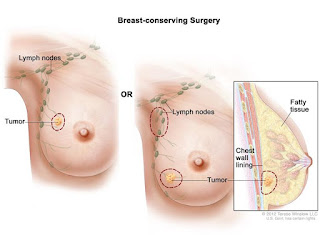Minimally Invasive Surgery For Benign Breast Lump
Breast lump is one of the most common complaint by
women attending breast clinic. In women younger than 30 years old, the
commonest diagnosis of breast lump is fibroadenoma, which is a benign (non-cancerous) breast
condition.
Other common benign conditions of the breast include fibrocystic changes,
sclerosing adenosis and ductal hyperplasia.
Diagnosis of benign breast disease is usually done by clinical
examination, imaging, and fine needle/ core biopsy; known as the triple
assessment, together they give sensitivity of 99%.
In the past, benign (non-cancerous) breast lumps that have been planned
for removal would have all been removed by an open surgical procedure
(excisional biopsy). Open surgery can be done under general or local
anaesthesia and required an incision in the breast. Currently there is a new
technique available (vacuum assisted excision biopsy) which can serve as an alternative to surgical excision
for women who desire excision but prefer to avoid surgery.
What is vacuum assisted excision?
Ultrasound
guided vacuum-assisted excision biopsy is a non –surgical procedure that can be
used to remove benign (non-cancerous) lumps in the breast. A needle is inserted
into the breast which uses a combination of sucking and cutting to remove the
breast lump. The aim of the procedure is to continue using the biopsy device
until the lump visible on ultrasound is removed.
How will it be done?
A local
anaesthetic injection into the skin of the breast at the site of the lump and
needle tract will be given. An incision a few millimetres long is made in the
breast and a 10- or 12- gauge needle attached to a suction device is inserted
into the area of the lump. Small amounts of tissue are sucked away through the
needle, and this is repeated until the lump appears to have gone. The doctor
uses ultrasound to monitor the procedure to see that the lump is removed
completely. After the lump removal, the needle device is taken out and pressure
is applied for a short time to help stop bleeding.
Advantages Of Vacuum Assisted Excision
Biopsy
- Can be done as an outpatient procedure, no admission required
- Can be done under local or general anaesthesia ( depending on the size and number of lumps)
- Smaller incision, better aesthetic outcome as less scarring
- Shorter recovery time
- Multiple lumps can be excised in the same procedures with minimal incisions
Risks of Vacuum Assisted Excision Biopsy
- There is a small risk of bleeding, in very rare instances, this may require open surgery
- Hematoma formation ( a blood filled swelling) at the site of the lump removed
- Infection
- Feeling faint during the procedure (when performed under local anaesthesia)
Most
patients experience mild to moderate pain after the procedure and are relieved
by oral painkiller. Sometimes bits of the lump may be missed, this may require
repeat procedure or surgery later depending on the type of lesions and
monitoring. In rare circumstances, the lesion may turn out to be cancerous
after the procedure even if the biopsy before this showed that the lump was
benign (non- cancerous).
In summary, vacuum
assisted excision biopsy of benign breast lump is a safe, effective, well-tolerated and minimally invasive procedure for
the complete removal of benign breast lumps. The minimal scarring and better
aesthetic outcome of the procedure has made it a popular choice in breast
centres worldwide for women receiving benign breast lump excision.






Comments
Post a Comment